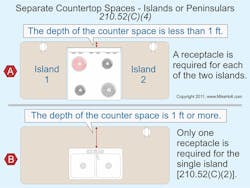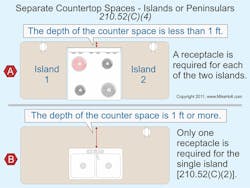Thank you for visiting one of our most popular classic articles. If you’d like to see updated information on this topic, please check out this recently published article, Kitchen Islands and New Receptacle Requirements in the 2020 NEC. |
This article is based on the 2011 NEC.
Q. What is the Code rule requiring the installation of a receptacle outlet for a peninsula or island countertop space?
A. At least one receptacle outlet must be installed at each island countertop space with a long dimension of 2 ft or more and a short dimension of 1 ft or more [210.52(C)(2)]. At least one receptacle outlet must be installed at each peninsular countertop with a long dimension of 2 ft or more (and a short dimension of 1 ft or more), measured from the connecting edge [210.52(C)(3)].
The Code doesn't require more than one receptacle outlet in an island or peninsular countertop space, regardless of the length of the countertop, unless the countertop is broken as described in 210.52(C)(4). When breaks occur in countertop spaces for rangetops, refrigerators, or sinks, each countertop space is considered as a separate countertop for determining receptacle placement [210.54(C)(4)].
If a range, counter-mounted cooking unit, or sink is installed in an island or peninsular countertop — and the depth of the counter behind the range, counter-mounted cooking unit, or sink is less than 12 in. — the countertop space is considered to be two separate countertop spaces, as shown in the Figure.
GFCI protection is required for all 15A and 20A, 125V receptacles that supply kitchen countertop surfaces [210.8(A)(6)].
About the Author

Mike Holt
Mike Holt is the owner of Mike Holt Enterprises (www.MikeHolt.com), one of the largest electrical publishers in the United States. He earned a master's degree in the Business Administration Program (MBA) from the University of Miami. He earned his reputation as a National Electrical Code (NEC) expert by working his way up through the electrical trade. Formally a construction editor for two different trade publications, Mike started his career as an apprentice electrician and eventually became a master electrician, an electrical inspector, a contractor, and an educator. Mike has taught more than 1,000 classes on 30 different electrical-related subjects — ranging from alarm installations to exam preparation and voltage drop calculations. He continues to produce seminars, videos, books, and online training for the trade as well as contribute monthly Code content to EC&M magazine.

